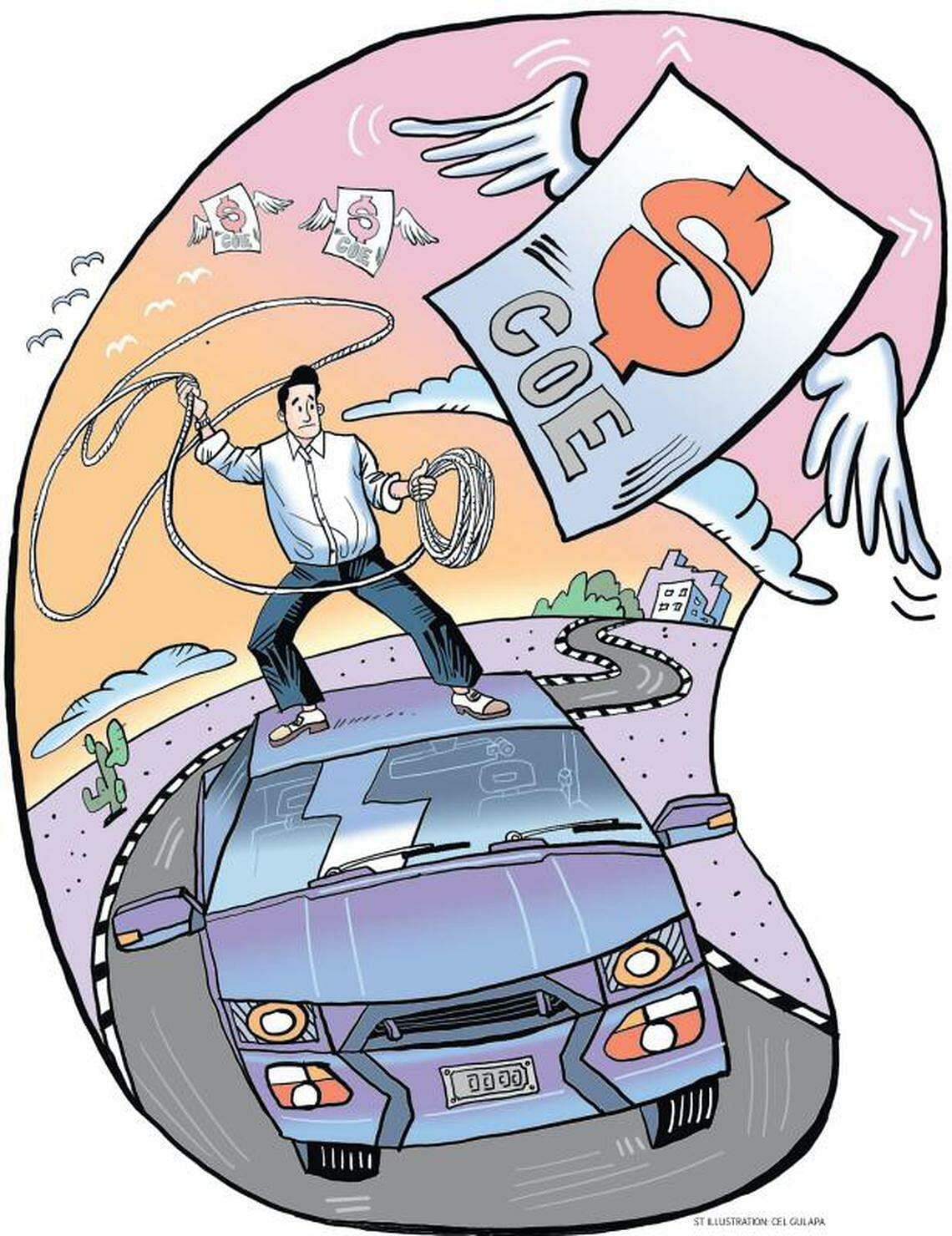SINGAPORE - There was never a dull moment in the transport sector in 2023 as certificate of entitlement (COE) premiums soared to new heights, public transport fares climbed, and Changi Airport Terminal 2 returned to full swing with a four-storey digital waterfall display as its centrepiece.
These are five of the biggest stories involving cars, planes and trains in 2023.
1. Record-breaking COE premiums
2023 will go down in the history books as the year that COE premiums for larger cars and the Open category crossed the $150,000 mark.
Driven by low supply and robust demand, premiums had already been surging for most of 2022 before hitting new highs in 2023.
For six consecutive tender exercises between August and October, new records were set in the larger car category, which peaked at $150,001, and the Open category, which reached a high of $158,004. The Open category can be used for any vehicle type except motorcycles but ends up almost exclusively for bigger, more powerful cars.
In May, the Government moved to bring forward and redistribute five-year COEs due to expire in the next projected supply peak. This was meant to be a one-off exercise, but prices continued rising.
In November, Acting Transport Minister Chee Hong Tat said COE supply will increase further in 2024 until the peak supply years in 2026 and 2027, using this “cut and fill” method.
With the boost in supply, COE prices ended lower across the board at the last tender of 2023 on Dec 20, with industry watchers expecting premiums to ease further in 2024.
Why it matters:
Sky-high COE prices in 2023 have made it harder for many Singaporeans to own a car, especially if they need one.
The soaring premiums have had ripple effects on other parts of the motor industry. For instance, used cars have become more expensive and drivers of private-hire vehicles face higher rental rates.
Industry observers have said the Government’s “cut and fill” approach will help to stabilise COE prices, but there are downsides, including the risk of more cars on the roads in the short term.
Panellists at a roundtable organised by The Straits Times in November largely agreed that the time is ripe to review and revamp the 33-year-old COE system. The unhappiness over the current system, coupled with a comprehensive MRT network and the introduction of a satellite-based road pricing system, provides an opportunity for this.
2. Next-generation ERP

After being delayed by several years due to the Covid-19 pandemic and a global chip shortage, work to install new on-board units (OBUs) for Singapore’s next-generation Electronic Road Pricing (ERP) system began in November.
In all, nearly one million vehicles will be fitted with the new devices, starting with about 20,000 fleet vehicles, which include public buses, fleet motorcycles and taxis.
Installation of the OBUs in new vehicles will start from the first quarter of 2024, while all other vehicles will have their existing in-vehicle units replaced in batches, based on the vehicle’s age.
The installation exercise is expected to conclude by the end of 2025.
Why it matters:
The new ERP system, or ERP 2.0, will replace the current 25-year-old system, which is reaching the end of its operational lifespan.
ERP 2.0 is satellite-based and promises a slew of new features, including providing motorists with traffic updates and the locations of silver zones, school zones, speed cameras and bus lanes.
But the key feature is its ability to charge motorists for distance travelled. For the moment, there are no immediate plans to introduce distance-based charging, and there will be no change to how motorists are charged for ERP during the transition from the old to the new system.

3. New-look Terminal 2
With a 14m-high, 17m-wide multimedia wall towering over its departure hall and an added 21,000 sq m in floor space, Changi Airport Terminal 2 reopened fully to travellers in November.
The upgraded terminal was completed ahead of schedule after 3½ years of engineering and expansion works. Other new features include a garden with a digital “sky” ceiling that emulates real-time weather conditions outside the terminal.
At the height of the pandemic in May 2020, T2 shut for upgrading before reopening in phases from 2022.
It is now the largest of the airport’s four terminals by handling capacity – it can serve 28 million passengers a year, compared with 23 million previously. This takes Changi Airport’s overall handling capacity to 90 million passengers yearly.

Why it matters:
With Changi Airport getting increasingly crowded, the full reopening of T2 has added much-needed capacity between now and when the Terminal 5 mega project is completed in the mid-2030s.
T5 will add 50 million passengers – more than the current capacities of T1 and T3 combined – to Changi Airport’s yearly capacity.
While not yet fully recovered, passenger traffic at Changi Airport crossed 90 per cent of pre-pandemic levels for the second straight month in November.
With global air travel demand expected to rise further in 2024 and 4.7 billion people forecast to travel, the airport has been positioning itself to capture this next bound of growth.
4. Consolidation in taxi, ride-hailing sector
Ride-hailing giant Grab’s pending acquisition of Singapore’s third-largest taxi operator, Trans-Cab, was one of several shake-ups in the point-to-point transport sector.
The takeover is being helmed by GrabRentals – Grab’s car rental arm – and includes about 2,200 cabs and more than 300 private-hire vehicles that Trans-Cab owns, as well as Trans-Cab’s vehicle workshop and fuel-pump operations.
The deal was expected to close by the fourth quarter of 2023, but Singapore’s competition watchdog raised concerns over the potential for the move to raise barriers to expansion and entry for rival platforms. It said a more detailed review of the proposed deal was needed.
In another sign of increasing consolidation, SMRT-owned Strides merged with Premier Taxis in May to form Singapore’s second-largest cab operator, Strides Premier, in a deal that also included a fleet of private-hire cars.
Why it matters:

Ride-hailing services have become a significant part of Singapore’s transport system, with more than 500,000 ride-hailing trips made daily. In comparison, about 80,000 street-hail trips, which can be made only by taxis, are completed per day.
Unlike in the early days of ride-hailing, when companies could splash out millions on driver incentives and fare discounts to gain market share, the picture today is different. Players such as Grab and Gojek are now prioritising profitability over growth.
Even though there are substantially more private-hire cars on the roads now, ride-hailing firms said supply has been unable to catch up with surging demand.
This mismatch has led to higher fares and longer waits for customers. Taxi and ride-hailing companies here also made several changes to their fare and commission structures in 2023.
The changing point-to-point transport landscape, including a rising preference among commuters for ride-hailing services, has prompted the authorities to start a review of the industry’s structure and regulatory framework. It is set to be completed by the second quarter of 2024.
5. Higher bus, MRT fares
On Dec 23, public transport fares for adults who pay by card rose by 10 or 11 cents, depending on the distance travelled. This is the highest fare increase on record by dollar value.
The hike, announced in September, came after the Public Transport Council (PTC) concluded its annual fare review and granted a 7 per cent increase in fares.
The PTC said fares in 2023 could have gone up by 22.6 per cent, spurred largely by a rise in energy prices. This is the highest allowable increase since 1998, when the council began using formulas to set a cap on fare changes.
Even so, the remaining increase of 15.6 per cent will be postponed to future fare review exercises. This is possible because the Government is providing an extra $300 million in public transport subsidies in 2024, on top of the more than $2 billion in subsidies it already shells out every year.
The PTC said the maximum 22.6 per cent increase comprised a 12 per cent increase derived from a new fare formula introduced for the 2023 exercise, as well as a 10.6 per cent hike rolled over from 2022.
Why it matters:
With the rising cost of living in Singapore, the fare increase will exact a toll on those trying to make ends meet.
In the light of this, MPs in October called for a freeze on future public transport fare hikes, or for the deferred 15.6 per cent increase to be eliminated.
Mr Chee shot down these suggestions, saying such moves would enlarge the existing funding gap for buses and trains, and lead to an even bigger bill for taxpayers in the future.
Public transport vouchers worth $50 each will be given to eligible lower-income households to cover about six months of the fare increase.
Analysts previously said the changes to the fare formula were unlikely to play a big part in determining the margin of future fare changes, compared with other factors such as inflation and energy costs.
While commuters should expect fares to continue rising in the coming years given the 15.6 per cent hike that has been rolled over, Mr Chee warned public transport operators to be disciplined in managing costs and improving productivity.


